The cosmic molybdenum-neodymium isotope correlation and the building material of the Earth
Affiliations | Corresponding Author | Cite as | Funding informationKeywords: nucleosynthetic isotope anomalies, molybdenum, neodymium, Earth composition, accretion
- Share this article





Article views:9,343Cumulative count of HTML views and PDF downloads.
- Download Citation
- Rights & Permissions
Abstract
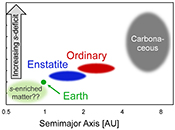
Figures and Tables
 Table 1 Molybdenum isotopic compositions of enstatite and ordinary chondrites. |  Figure 1 Mo isotopic composition of enstatite and ordinary chondrites. Error bars indicate external uncertainties derived from the 2 s.d. obtained for terrestrial rock standards analysed in this study (if N < 4) or Student's t-values 95 % confidence interval of multiple solution replicates of a sample (if N ≥ 4) (Table 1). Shaded areas indicate mean compositions of enstatite and ordinary chondrites as well as the terrestrial rock standard BHVO-2 with their Student's t-values 95 % confidence intervals. | 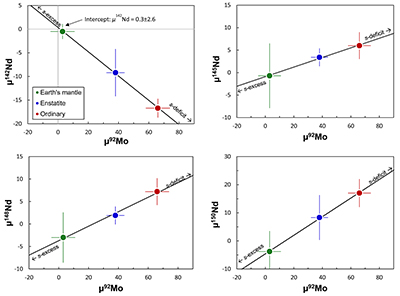 Figure 2 Cosmic Mo-Nd isotope correlation. Mo isotopic data for enstatite and ordinary chondrites from this study, Nd isotopic data are from Burkhardt et al. (2016). For a plot with carbonaceous chondrites included see Figure S-4. Regression of µ142Nd versus µ92Mo calculated using IsoPlot. The good alignment of the data combined with the observation that both 142Nd and non-radiogenic Nd isotopes are correlated with µ92Mo indicates that the 142Nd difference between Earth’s mantle and chondrites is solely nucleosynthetic in origin. | 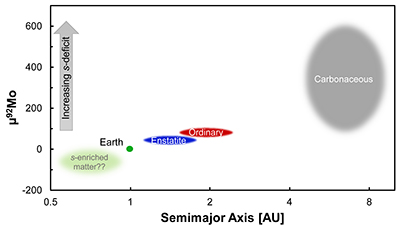 Figure 3 µ92Mo versus heliocentric distance. Range of µ92Mo for carbonaceous chondrites from Burkhardt et al. (2011). Heliocentric distances are based on the Grand Tack model, in which bodies between 3 and 6 AU were largely incorporated into Jupiter. |
| Table 1 | Figure 1 | Figure 2 | Figure 3 |
Supplementary Figures and Tables
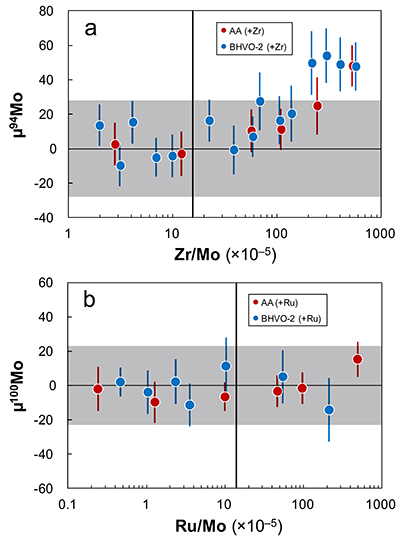 Figure S-1 Doping tests for interference corrections from Zr and Ru. (a) Measured µ94Mo for samples doped with Zr. (b) Measured µ100Mo for samples doped with Ru. The grey area represents the external reproducibility (2 s.d.) defined by repeated analyses of different digestions of the (undoped) BHVO-2 terrestrial basalt standard. Vertical lines represent the maximum values observed for samples in this study. | 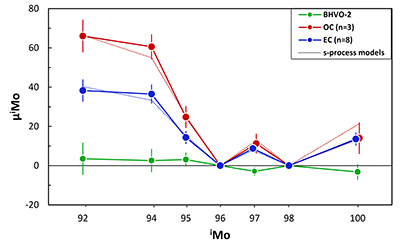 Figure S-2 µiMo vs. iMo showing the average Mo isotopic compositions for enstatite and ordinary chondrites as well as BHVO-2. Dotted lines represent the expected composition for deficits in s-process Mo nuclides relative to terrestrial Mo, calculated using the stellar model of Arlandini et al. (1999). | 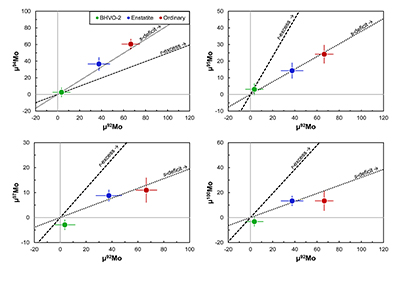 Figure S-3 Plots of µiMo vs. µ92Mo with group means for enstatite and ordinary chondrites as well as BHVO-2. Dotted and dashed lines are mixing lines between terrestrial Mo and s- or r-process Mo, respectively (Arlandini et al., 1999). | 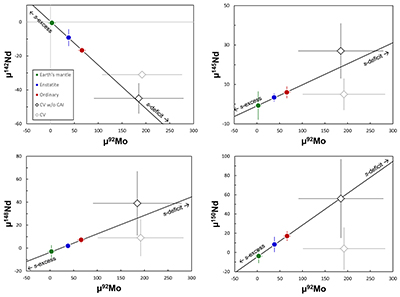 Figure S-4 Plots of µiNd vs. µ92Mo. Bulk CV chondrites do not plot on the Mo-Nd correlation line defined by enstatite chondrites, ordinary chondrites and Earth’s mantle. Using mass balance calculations (Section S-2 and Table S-2), however, the effect of CAIs within CV chondrites can be eliminated and the resulting isotopic composition of CAI-free CV chondrites plot on the aforementioned correlation line. |  Table S-1 Compilation of Mo isotopic compositions of CV chondrites. |  Table S-2 Isotopic mass balance calculations for Mo (CAI fraction = 0.03). |
| Figure S-1 | Figure S-2 | Figure S-3 | Figure S-4 | Table S-1 | Table S-2 |
top
Introduction
Earth probably formed through the collision of numerous planetesimals and planetary embryos. Remnants of these bodies may today still reside in the asteroid belt and so some of Earth’s building material might have been sampled by meteorites. This raises the question of whether meteorites are representative for the entire suite of bodies accreted by the Earth over time. Addressing this issue is critical not only for understanding the accretion history of the Earth, but also for constraining its chemical composition and early differentiation.
The most powerful constraints for establishing potential genetic links between meteorites and the Earth come from nucleosynthetic isotope anomalies, which arise through the heterogeneous distribution of presolar matter in the solar protoplanetary disk. These isotopic variations have been documented for several elements, including lithophile (e.g., Cr, Ti, Nd; Carlson et al., 2007
Carlson, R.W., Boyet, M., Horan, M.F. (2007) Chondrite barium, neodymium, and samarium isotopic heterogeneity and early earth differentation. Science 316, 1175–1178.
; Trinquier et al., 2007Trinquier, A., Birck, J.L., Allègre, C.J. (2007) Widespread Cr-54 heterogeneity in the inner solar system. Astrophysical Journal 655, 1179–1185.
, 2009Trinquier, A., Elliott, T., Ulfbeck, D., Coath, C., Krot, A.N., Bizzarro, M. (2009) Origin of Nucleosynthetic Isotope Heterogeneity in the Solar Protoplanetary Disk. Science 324, 374–376.
; Burkhardt et al., 2016Burkhardt, C., Borg, L.E., Brennecka, G.A., Shollenberger, Q.R., Dauphas, N., Kleine, T. (2016) A nucleosynthetic origin for the Earth’s anomalous 142Nd composition. Nature 537, 394–398.
) as well as moderately siderophile (e.g., Ni, Mo; Dauphas et al., 2002Dauphas, N., Marty, B., Reisberg, L. (2002) Molybdenum nucleosynthetic dichotomy revealed in primitive meteorites. Astrophysical Journal 569, L139–L142.
; Regelous et al., 2008Regelous, M., Elliott, T., Coath, C.D. (2008) Nickel isotope heterogeneity in the early Solar System. Earth and Planetary Science Letters 272, 330–338.
; Burkhardt et al., 2011Burkhardt, C., Kleine, T., Oberli, F., Pack, A., Bourdon, B., Wieler, R. (2011) Molybdenum isotope anomalies in meteorites: Constraints on solar nebula evolution and origin of the Earth. Earth and Planetary Science Letters 312, 390–400.
) and highly siderophile elements (e.g., Ru; Chen et al., 2010Chen, J.H., Papanastassiou, D.A., Wasserburg, G.J. (2010) Ruthenium endemic isotope effects in chondrites and differentiated meteorites. Geochimica et Cosmochimica Acta 74, 3851–3862.
; Fischer-Gödde et al., 2015Fischer-Gödde, M., Burkhardt, C., Kruijer, T.S., Kleine, T. (2015) Ru isotope heterogeneity in the solar protoplanetary disk. Geochimica et Cosmochimica Acta 168, 151–171.
). As the present-day mantle composition of these elements has been set during different stages of Earth’s accretion, the nucleosynthetic isotope signatures do not only provide information on whether or not specific meteorites are suitable building blocks of the Earth, but they also make it possible to identify potential changes in the nature of Earth’s building material over time (Dauphas et al., 2004Dauphas, N., Davis, A.M., Marty, B., Reisberg, L. (2004) The cosmic molybdenum-ruthenium isotope correlation. Earth and Planetary Science Letters 226, 465–475.
; Dauphas, 2017Dauphas, N. (2017) The isotopic nature of the Earth’s accreting material through time. Nature 541, 521–524.
).Several prior studies attempted to constrain the origin of Earth’s building material by assessing which combination of known meteorites yields the isotopic composition of Earth’s mantle (e.g., Dauphas et al., 2014
Dauphas, N., Chen, J.H., Zhang, J., Papanastassiou, D.A., Davis, A.M., Travaglio, C. (2014) Calcium-48 isotopic anomalies in bulk chondrites and achondrites: Evidence for a uniform isotopic reservoir in the inner protoplanetary disk. Earth and Planetary Science Letters 407, 96–108.
; Dauphas, 2017Dauphas, N. (2017) The isotopic nature of the Earth’s accreting material through time. Nature 541, 521–524.
). As enstatite chondrites are the only meteorite class for which no or only very small nucleosynthetic isotope anomalies are observed (Trinquier et al., 2007Trinquier, A., Birck, J.L., Allègre, C.J. (2007) Widespread Cr-54 heterogeneity in the inner solar system. Astrophysical Journal 655, 1179–1185.
, 2009Trinquier, A., Elliott, T., Ulfbeck, D., Coath, C., Krot, A.N., Bizzarro, M. (2009) Origin of Nucleosynthetic Isotope Heterogeneity in the Solar Protoplanetary Disk. Science 324, 374–376.
; Regelous et al., 2008Regelous, M., Elliott, T., Coath, C.D. (2008) Nickel isotope heterogeneity in the early Solar System. Earth and Planetary Science Letters 272, 330–338.
; Dauphas et al., 2014Dauphas, N., Chen, J.H., Zhang, J., Papanastassiou, D.A., Davis, A.M., Travaglio, C. (2014) Calcium-48 isotopic anomalies in bulk chondrites and achondrites: Evidence for a uniform isotopic reservoir in the inner protoplanetary disk. Earth and Planetary Science Letters 407, 96–108.
), such models typically predict that Earth largely consists of enstatite chondrite-like material. This enstatite chondrite-Earth model was initially proposed based on the similar O isotopic compositions of Earth and enstatite chondrites (Javoy, 1995Javoy, M. (1995) The integral enstatite chondrite model of the Earth. Geophysical Research Letters 22, 2219–2222.
), but gained additional strength owing to the isotopic similarity between these two bodies observed for several other elements (Javoy et al., 2010Javoy, M., Kaminski, E., Guyot, F., Andrault, D., Sanloup, C., Moreira, M., Labrosse, S., Jambon, A., Agrinier, P., Davaille, A., Jaupart, C. (2010) The chemical composition of the Earth: Enstatite chondrite models. Earth and Planetary Science Letters 293, 259–268.
). Because enstatite chondrites and Earth’s upper mantle are chemically quite different, however, the enstatite chondrite-Earth model in its original form requires that the Earth’s mantle is chemically stratified (Javoy et al., 2010Javoy, M., Kaminski, E., Guyot, F., Andrault, D., Sanloup, C., Moreira, M., Labrosse, S., Jambon, A., Agrinier, P., Davaille, A., Jaupart, C. (2010) The chemical composition of the Earth: Enstatite chondrite models. Earth and Planetary Science Letters 293, 259–268.
). To avoid these complications, more recent versions of this model have argued that enstatite chondrites do not represent the actual building blocks of the Earth, but simply sample the same isotopic solar nebula reservoir as the bodies accreted by the Earth (Dauphas et al., 2014Dauphas, N., Chen, J.H., Zhang, J., Papanastassiou, D.A., Davis, A.M., Travaglio, C. (2014) Calcium-48 isotopic anomalies in bulk chondrites and achondrites: Evidence for a uniform isotopic reservoir in the inner protoplanetary disk. Earth and Planetary Science Letters 407, 96–108.
; Dauphas, 2017Dauphas, N. (2017) The isotopic nature of the Earth’s accreting material through time. Nature 541, 521–524.
).All these prior models are based on the predication that meteorites are representative of the entire material that was available to build the larger embryos and terrestrial planets. This assumption is questionable, however, given that most meteorites probably formed at greater heliocentric distances than the main building material of the Earth. As such, it has also been argued that the building material of the Earth is not represented by known meteorites, but that it has been entirely incorporated into the terrestrial planets (Drake and Righter, 2002
Drake, M.J., Righter, K. (2002) Determining the composition of the Earth. Nature 416, 39–44.
; Burkhardt et al., 2011Burkhardt, C., Kleine, T., Oberli, F., Pack, A., Bourdon, B., Wieler, R. (2011) Molybdenum isotope anomalies in meteorites: Constraints on solar nebula evolution and origin of the Earth. Earth and Planetary Science Letters 312, 390–400.
, 2016Burkhardt, C., Borg, L.E., Brennecka, G.A., Shollenberger, Q.R., Dauphas, N., Kleine, T. (2016) A nucleosynthetic origin for the Earth’s anomalous 142Nd composition. Nature 537, 394–398.
). From an isotopic standpoint this model is difficult to test, because for most elements (e.g., O, Cr, Ti) the isotopic composition of the Earth is intermediate between the isotopic variations measured for meteorites. However, for Mo this does not seem to be the case and almost all meteorites are characterised by a deficit of Mo produced in the slow neutron capture process (s-process) of stellar nucleosynthesis (Dauphas et al., 2002Dauphas, N., Marty, B., Reisberg, L. (2002) Molybdenum nucleosynthetic dichotomy revealed in primitive meteorites. Astrophysical Journal 569, L139–L142.
; Burkhardt et al., 2011Burkhardt, C., Kleine, T., Oberli, F., Pack, A., Bourdon, B., Wieler, R. (2011) Molybdenum isotope anomalies in meteorites: Constraints on solar nebula evolution and origin of the Earth. Earth and Planetary Science Letters 312, 390–400.
). Until now, enstatite chondrites and IAB iron meteorites are the only meteorites for which no clearly resolved Mo isotope anomalies have been identified, although there are hints of a small deficit in s-process Mo in enstatite chondrites as well (Burkhardt et al., 2011Burkhardt, C., Kleine, T., Oberli, F., Pack, A., Bourdon, B., Wieler, R. (2011) Molybdenum isotope anomalies in meteorites: Constraints on solar nebula evolution and origin of the Earth. Earth and Planetary Science Letters 312, 390–400.
). The presence of such a Mo s-process deficit in enstatite chondrites, if confirmed, would place strict constraints on the possible contribution of enstatite chondrite-like material accreted by the Earth, and would allow assessment of the more general question of whether meteorites are representative of the building material of the Earth. To address these issues, we obtained new high-precision Mo isotopic data for enstatite chondrites.top
Mo Isotope Anomalies in Enstatite Chondrites and the Cosmic Mo-Nd Isotope Correlation
Eight enstatite chondrites as well as three ordinary and four CV chondrites were selected for this study. Details about sample preparation, the purification of Mo from the sample matrix, and the Mo isotope measurements using the ThermoScientific Neptune Plus MC-ICP-MS at Münster are given in the Supplementary Information. The Mo isotopic compositions of the chondrites were normalised to the terrestrial 98Mo/96Mo using the exponential law, and are reported in µiMo values as the parts per million deviation from the compositions measured for the Alfa Aesar Mo standard solution. Each sample was analysed multiple times and the µiMo values reported in Table 1 represent mean values for pooled solution replicates (N = 3–5) together with their associated uncertainties. The accuracy and precision of the measurements were assessed by replicate digestions and multiple measurements of the USGS Hawaiian basalt BHVO-2, for which we obtained µiMo ~0 (Table 1).
Table 1 Molybdenum isotopic compositions of enstatite and ordinary chondrites.
| Sample | Type | Na | µ92Mob | µ94Mob | µ95Mob | µ97Mob | µ100Mob |
| BHVO-2 | Basalt | 24 (3) | 3 ± 8 | 3 ± 6 | 3 ± 3 | -3 ± 2 | -3 ± 4 |
| ±2 s.d. | ± 37 | ± 27 | ± 16 | ± 10 | ± 19 | ||
| Enstatite chondrites | |||||||
| LON 94100 | EL6 | 3 | 18 ± 37 | 21 ± 27 | 10 ± 16 | 8 ± 10 | 11 ± 19 |
| LAP 10130 | EL6 | 5 (2) | 51 ± 17 | 44 ± 22 | 23 ± 20 | 14 ± 7 | 6 ± 13 |
| MAC 02747 | EL4 | 5 | 36 ± 26 | 34 ± 12 | 8 ± 7 | 6 ± 10 | 13 ± 16 |
| TIL 91714 | EL5 | 4 | 29 ± 24 | 35 ± 24 | 9 ± 12 | 7 ± 9 | 17 ± 16 |
| ALHA 81021 | EL6 | 5 | 43 ± 16 | 42 ± 19 | 19 ± 10 | 10 ± 5 | 10 ± 6 |
| Khairpur | EL6 | 7 (2) | 27 ± 8 | 24 ± 5 | 11 ± 9 | 5 ± 5 | 12 ± 13 |
| EL mean | 29 | 35 ± 6 | 33 ± 5 | 13 ± 4 | 8 ± 2 | 12 ± 4 | |
| EET 87747 | EH4 | 5 | 48 ± 29 | 45 ± 26 | 19 ± 14 | 11 ± 10 | 16 ± 9 |
| Abee | EH4 | 5 | 49 ± 8 | 46 ± 10 | 15 ± 9 | 9 ± 9 | 22 ± 12 |
| EH mean | 10 | 49 ± 11 | 46 ± 11 | 17 ± 7 | 10 ± 5 | 19 ± 6 | |
| Mean (EH, EL) | 39 | 38 ± 6 | 36 ± 5 | 14 ± 3 | 9 ± 2 | 14 ± 3 | |
| Ordinary chondrites | |||||||
| Braunschweig | L5 | 3 | 73 ± 37 | 60 ± 27 | 22 ± 16 | 8 ± 10 | 8 ± 19 |
| Kunashak | L5 | 3 | 65 ± 37 | 60 ± 27 | 20 ± 16 | 12 ± 10 | 12 ± 19 |
| Gao Guenie | H5 | 4 | 62 ± 19 | 62 ± 19 | 30 ± 15 | 13 ± 14 | 20 ± 15 |
| Mean (L, H) | 10 | 66 ± 8 | 61 ± 6 | 25 ± 6 | 11 ± 5 | 14 ± 8 | |
a Number of analyses of the same sample; number in parenthesis indicates number of replicate digestions.
b Molybdenum isotope data are mass-bias corrected by normalising to 98Mo/96Mo = 1.453171 and using the exponential law. Data are reported relative to the terrestrial bracketing standard: µiMo = (µiMo/96Mosample / µiMo/96Mostandard –1) × 106. Uncertainties for samples measured more than three times are given as Student's t-values 95 % confidence intervals from replicate analyses of the same sample. For samples measured n ≤ 3 times (LON 94100, Braunschweig, Kunashak), quoted uncertainties are given as external uncertainties as defined by the standard deviation (2 s.d.) of repeated analyses from replicate digestions of BHVO-2 reference samples.
The new data for enstatite and ordinary chondrites show well-resolved Mo isotope anomalies relative to the terrestrial solution standard (i.e. µiMo = 0) and the rock standard BHVO-2 that was processed and analysed together with the chondrite samples (Table 1, Fig. 1). The anomalies are most pronounced for µ92Mo and µ94Mo, for which most (6 out of 8) enstatite chondrites show resolved excesses (Fig. 1). The mean composition of all eight investigated enstatite chondrites display well-resolved positive µiMo anomalies for all Mo isotopes (Fig. 1). Compared to the enstatite chondrites, the ordinary chondrites exhibit larger Mo isotope anomalies, consistent with results of a prior study (Burkhardt et al., 2011
Burkhardt, C., Kleine, T., Oberli, F., Pack, A., Bourdon, B., Wieler, R. (2011) Molybdenum isotope anomalies in meteorites: Constraints on solar nebula evolution and origin of the Earth. Earth and Planetary Science Letters 312, 390–400.
). As is evident from plots of µiMo versus µ92Mo, the Mo isotope anomalies are correlated as expected for the heterogeneous distribution of s-process matter, indicating that enstatite and ordinary chondrites are characterised by a deficit in s-process Mo compared to Earth’s mantle (Fig. S-3).
Figure 1 Mo isotopic composition of enstatite and ordinary chondrites. Error bars indicate external uncertainties derived from the 2 s.d. obtained for terrestrial rock standards analysed in this study (if N < 4) or Student's t-values 95 % confidence interval of multiple solution replicates of a sample (if N ≥ 4) (Table 1). Shaded areas indicate mean compositions of enstatite and ordinary chondrites as well as the terrestrial rock standard BHVO-2 with their Student's t-values 95 % confidence intervals.
As for Mo, the Nd isotope compositions of chondrites also reveal an increasing deficit in s-process isotopes from enstatite to ordinary chondrites (Burkhardt et al., 2016
Burkhardt, C., Borg, L.E., Brennecka, G.A., Shollenberger, Q.R., Dauphas, N., Kleine, T. (2016) A nucleosynthetic origin for the Earth’s anomalous 142Nd composition. Nature 537, 394–398.
). The Mo and Nd isotope anomalies in these chondrites plot on a single correlation line together with the composition of Earth’s mantle (Fig. 2). Of note, the Mo-Nd isotope correlation holds regardless of which Nd isotope is used (Figs. 2, S-4). As both the Mo and Nd isotope variations reflect a deficit in s-process matter, this cosmic Mo-Nd isotope correlation most likely results from the heterogeneous distribution of a single presolar carrier enriched in s-process Mo and Nd.
Figure 2 Cosmic Mo-Nd isotope correlation. Mo isotopic data for enstatite and ordinary chondrites from this study, Nd isotopic data are from Burkhardt et al. (2016)
Burkhardt, C., Borg, L.E., Brennecka, G.A., Shollenberger, Q.R., Dauphas, N., Kleine, T. (2016) A nucleosynthetic origin for the Earth’s anomalous 142Nd composition. Nature 537, 394–398.
. For a plot with carbonaceous chondrites included see Figure S-4. Regression of µ142Nd versus µ92Mo calculated using IsoPlot. The good alignment of the data combined with the observation that both 142Nd and non-radiogenic Nd isotopes are correlated with µ92Mo indicates that the 142Nd difference between Earth’s mantle and chondrites is solely nucleosynthetic in origin.In spite of their large Mo isotope anomalies, bulk CV chondrites do not show significant nucleosynthetic Nd isotope anomalies and therefore do not plot on the Mo-Nd isotope correlation (Fig. S-4). Burkhardt et al. (2016)
Burkhardt, C., Borg, L.E., Brennecka, G.A., Shollenberger, Q.R., Dauphas, N., Kleine, T. (2016) A nucleosynthetic origin for the Earth’s anomalous 142Nd composition. Nature 537, 394–398.
attributed the absence of clearly resolvable nucleosynthetic Nd isotope anomalies in CV chondrites to the admixture of isotopically anomalous Ca-Al-rich inclusions (CAIs) to these samples. Mathematical removal of CAIs from the measured bulk CV composition shows that a hypothetical CAI-free CV chondrite would not only have a large s-process deficit for Nd (e.g., µ150Nd ≈ 50), but would also plot on the Mo-Nd isotope correlation together with enstatite and ordinary chondrites (Fig. S-4). Thus, the displacement of CV chondrites from the Mo-Nd isotope correlation most likely reflects the admixture of CAIs to these samples.top
Nature of Earth's Building Material
There is no a priori reason why the Earth’s mantle would plot on a single Mo-Nd correlation line together with enstatite and ordinary chondrites. This is because, as a moderately siderophile element, most of the Mo present in Earth’s mantle derives from the last 10–20 % of accretion (Walker et al., 2015
Walker, R.J., Bermingham, K., Liu, J., Puchtel, I.S., Touboul, M., Worsham, E.A. (2015) In search of late-stage planetary building blocks. Chemical Geology 411, 125–142.
; Dauphas, 2017Dauphas, N. (2017) The isotopic nature of the Earth’s accreting material through time. Nature 541, 521–524.
), whereas Nd, as a lithophile element, records the average composition of the material added to the Earth during its entire growth history. Thus, Mo and Nd record different stages of Earth’s accretion and any change in the isotopic composition of the accreting material would have affected the Mo and Nd isotopic compositions of Earth’s mantle differently. For instance, the Mo isotopic data would be consistent with accretion of the first ~80–90 % of the Earth from enstatite chondrite-like material (which would have left no impact on the Mo isotopic composition of the present-day Earth’s mantle because almost all of that Mo would have been sequestrated into the core), followed by the accretion of the final ~10–20 % of distinct material characterised by µ92Mo = 0. In this scenario, the Nd isotopic composition of Earth’s mantle would predominantly record the first ~80–90 % of accretion and would, therefore, be enstatite chondrite-like. However, in this case the Earth’s mantle would not plot on a Mo-Nd isotope correlation line together with enstatite and ordinary chondrites. Instead, the observed correlation of Mo and Nd isotopes (Fig. 2) indicates that the nucleosynthetic signatures and, hence, genetic makeup of Earth’s building material did not change significantly as accretion proceeded.Akin to the Mo-Nd correlation observed here, meteorites define a cosmic Mo-Ru isotope correlation that also reflects variable s-process deficits in the meteorites (Dauphas et al., 2004
Dauphas, N., Davis, A.M., Marty, B., Reisberg, L. (2004) The cosmic molybdenum-ruthenium isotope correlation. Earth and Planetary Science Letters 226, 465–475.
). As a highly siderophile element, Ru predominantly reflects the addition of primitive material to the Earth’s mantle after the cessation of core formation (the ‘late veneer’; e.g., Walker et al., 2015Walker, R.J., Bermingham, K., Liu, J., Puchtel, I.S., Touboul, M., Worsham, E.A. (2015) In search of late-stage planetary building blocks. Chemical Geology 411, 125–142.
). Of note, enstatite chondrites also show Ru isotope anomalies (e.g., µ100Ru = –8 ± 4), which, as for Mo and Nd, reflect a deficit in s-process matter compared to Earth’s mantle (Fischer-Gödde and Kleine, 2017Fischer-Gödde, M., Kleine, T. (2017) Ruthenium isotopic evidence for an inner Solar System origin of the late veneer. Nature 541, 525–527.
).Taken together, the Mo, Nd and Ru isotopic data demonstrate that throughout its entire accretion history the building material of the Earth, including the late veneer, was on average characterised by an excess in s-process matter compared to chondrites, including enstatite chondrites. As such, the enstatite chondrite-Earth model loses its viability. This model in its original form (Javoy, 1995
Javoy, M. (1995) The integral enstatite chondrite model of the Earth. Geophysical Research Letters 22, 2219–2222.
; Javoy et al., 2010Javoy, M., Kaminski, E., Guyot, F., Andrault, D., Sanloup, C., Moreira, M., Labrosse, S., Jambon, A., Agrinier, P., Davaille, A., Jaupart, C. (2010) The chemical composition of the Earth: Enstatite chondrite models. Earth and Planetary Science Letters 293, 259–268.
) was based on the observation that enstatite chondrites are the only meteorites not showing mass-independent isotope anomalies compared to Earth. However, with the new Mo, Nd and Ru isotopic data, this basic assumption no longer holds true.Dauphas (2017)
Dauphas, N. (2017) The isotopic nature of the Earth’s accreting material through time. Nature 541, 521–524.
, using nucleosynthetic isotope anomalies for several other elements, also argued that the genetic heritage of Earth's accreting material did not change over time. By assuming that Earth's building material consisted of four components whose isotopic compositions are represented by enstatite, ordinary as well as CI and CV/CO chondrites, Dauphas (2017)Dauphas, N. (2017) The isotopic nature of the Earth’s accreting material through time. Nature 541, 521–524.
calculated that the isotopic composition of Earth’s mantle is best reproduced if the Earth accreted almost exclusively from enstatite chondrite-like material throughout its accretion history. However, with the new Mo isotopic data of the present study, and the cosmic Mo-Nd isotope correlation, it becomes clear that no combination of known chondrites results in the Mo and Nd isotopic compositions of Earth’s mantle. This is because all chondrites, including enstatite chondrites, are characterised by a deficit in s-process nuclides compared to Earth’s mantle (Fig. 2). Consequently, the Earth cannot solely consist of known meteorites but instead accreted from material that on average was characterised by an excess in s-process matter compared to known meteorites. This does not exclude that meteorites contributed to the building material of the Earth, but any such contribution must be balanced by the accretion of s-process enriched material to the Earth. This material is not present in our current meteorite collections, but, if it existed, might have been sampled by Mercury and Venus (Fig. 3). We note, however, that the isotopic data taken together neither require nor exclude the contribution of meteorites to the building material of the Earth.
Figure 3 µ92Mo versus heliocentric distance. Range of µ92Mo for carbonaceous chondrites from Burkhardt et al. (2011)
Burkhardt, C., Kleine, T., Oberli, F., Pack, A., Bourdon, B., Wieler, R. (2011) Molybdenum isotope anomalies in meteorites: Constraints on solar nebula evolution and origin of the Earth. Earth and Planetary Science Letters 312, 390–400.
. Heliocentric distances are based on the Grand Tack model, in which bodies between 3 and 6 AU were largely incorporated into Jupiter.The s-process enriched nature of the Earth compared to chondrites has important implications for 146Sm–142Nd chronometry. Different µ142Nd compositions of chondrites and the Earth’s mantle were initially interpreted to result from a very early global differentiation of the silicate Earth (e.g., Boyet and Carlson, 2005
Boyet, M., Carlson, R.W. (2005) 142Nd evidence for early (>4.53 Ga) global differentiation of the silicate Earth. Science 309, 576–581.
). However, on the basis of correlations for non-radiogenic Nd isotope anomalies, Burkhardt et al. (2016)Burkhardt, C., Borg, L.E., Brennecka, G.A., Shollenberger, Q.R., Dauphas, N., Kleine, T. (2016) A nucleosynthetic origin for the Earth’s anomalous 142Nd composition. Nature 537, 394–398.
recently showed that this 142Nd difference is nucleosynthetic in origin. The observation that the Mo-Nd isotope correlation lines defined by Earth’s mantle together with enstatite and ordinary chondrites include the µ142Nd–µ92Mo correlation confirms this finding. The intercept of this correlation at µ92Mo = 0 is µ142Nd = 0.3 ± 2.6, demonstrating that once nucleosynthetic isotope variations are taken into account, the Earth’s mantle has no radiogenic 142Nd anomaly relative to chondrites and that, therefore, no early differentiation is required to account for the present-day 142Nd composition of the accessible Earth’s mantle.top
Acknowledgements
We thank the Meteorite Working Group (NASA), the National History Musuem (London) and R. Bartoschewitz for providing samples. Constructive reviews from two anonymous referees and editor G. Pearson helped improve the manuscript and are gratefully acknowledged. We also thank G. Budde for assistance with lab work and MC-ICP-MS measurements. This work was funded by the Deutsche Forschungsgemeinschaft (SFB-TRR 170, subproject B3-1). J.R. was partially supported by the Deutsche Forschungsgemeinschaft (grant KL 1857/4 to T.K.), and C.B. was supported by the European Research Council Consolidator Grant ISOCORE to T.K. (grant agreement no. 616564). This is TRR 170 publication no. 22.
Editor: Graham Pearson
top
References
Boyet, M., Carlson, R.W. (2005) 142Nd evidence for early (>4.53 Ga) global differentiation of the silicate Earth. Science 309, 576–581.
 Show in context
Show in contextDifferent µ142Nd compositions of chondrites and the Earth’s mantle were initially interpreted to result from a very early global differentiation of the silicate Earth (e.g., Boyet and Carlson, 2005).
View in article
Burkhardt, C., Kleine, T., Oberli, F., Pack, A., Bourdon, B., Wieler, R. (2011) Molybdenum isotope anomalies in meteorites: Constraints on solar nebula evolution and origin of the Earth. Earth and Planetary Science Letters 312, 390–400.
 Show in context
Show in contextThese isotopic variations have been documented for several elements, including lithophile (e.g., Cr, Ti, Nd; Carlson et al., 2007; Trinquier et al., 2007, 2009; Burkhardt et al., 2016) as well as moderately siderophile (e.g., Ni, Mo; Dauphas et al., 2002; Regelous et al., 2008; Burkhardt et al., 2011) and highly siderophile elements (e.g., Ru; Chen et al., 2010; Fischer-Gödde et al., 2015).
View in article
As such, it has also been argued that the building material of the Earth is not represented by known meteorites, but that it has been entirely incorporated into the terrestrial planets (Drake and Righter, 2002; Burkhardt et al., 2011, 2016).
View in article
However, for Mo this does not seem to be the case and almost all meteorites are characterised by a deficit of Mo produced in the slow neutron capture process (s-process) of stellar nucleosynthesis (Dauphas et al., 2002; Burkhardt et al., 2011).
View in article
Until now, enstatite chondrites and IAB iron meteorites are the only meteorites for which no clearly resolved Mo isotope anomalies have been identified, although there are hints of a small deficit in s-process Mo in enstatite chondrites as well (Burkhardt et al., 2011).
View in article
Compared to the enstatite chondrites, the ordinary chondrites exhibit larger Mo isotope anomalies, consistent with results of a prior study (Burkhardt et al., 2011).
View in article
Figure 3 [...] Range of µ92Mo for carbonaceous chondrites from Burkhardt et al. (2011).
View in article
Burkhardt, C., Borg, L.E., Brennecka, G.A., Shollenberger, Q.R., Dauphas, N., Kleine, T. (2016) A nucleosynthetic origin for the Earth’s anomalous 142Nd composition. Nature 537, 394–398.
 Show in context
Show in contextThese isotopic variations have been documented for several elements, including lithophile (e.g., Cr, Ti, Nd; Carlson et al., 2007; Trinquier et al., 2007, 2009; Burkhardt et al., 2016) as well as moderately siderophile (e.g., Ni, Mo; Dauphas et al., 2002; Regelous et al., 2008; Burkhardt et al., 2011) and highly siderophile elements (e.g., Ru; Chen et al., 2010; Fischer-Gödde et al., 2015).
View in article
As such, it has also been argued that the building material of the Earth is not represented by known meteorites, but that it has been entirely incorporated into the terrestrial planets (Drake and Righter, 2002; Burkhardt et al., 2011, 2016).
View in article
As for Mo, the Nd isotope compositions of chondrites also reveal an increasing deficit in s-process isotopes from enstatite to ordinary chondrites (Burkhardt et al., 2016).
View in article
Figure 2 [...] Mo isotopic data for enstatite and ordinary chondrites from this study, Nd isotopic data are from Burkhardt et al. (2016).
View in article
Burkhardt et al. (2016) attributed the absence of clearly resolvable nucleosynthetic Nd isotope anomalies in CV chondrites to the admixture of isotopically anomalous Ca-Al-rich inclusions (CAIs) to these samples.
View in article
However, on the basis of correlations for non-radiogenic Nd isotope anomalies, Burkhardt et al. (2016) recently showed that this 142Nd difference is nucleosynthetic in origin.
View in article
Carlson, R.W., Boyet, M., Horan, M.F. (2007) Chondrite barium, neodymium, and samarium isotopic heterogeneity and early earth differentation. Science 316, 1175–1178.
 Show in context
Show in contextThese isotopic variations have been documented for several elements, including lithophile (e.g., Cr, Ti, Nd; Carlson et al., 2007; Trinquier et al., 2007, 2009; Burkhardt et al., 2016) as well as moderately siderophile (e.g., Ni, Mo; Dauphas et al., 2002; Regelous et al., 2008; Burkhardt et al., 2011) and highly siderophile elements (e.g., Ru; Chen et al., 2010; Fischer-Gödde et al., 2015).
View in article
Chen, J.H., Papanastassiou, D.A., Wasserburg, G.J. (2010) Ruthenium endemic isotope effects in chondrites and differentiated meteorites. Geochimica et Cosmochimica Acta 74, 3851–3862.
 Show in context
Show in contextThese isotopic variations have been documented for several elements, including lithophile (e.g., Cr, Ti, Nd; Carlson et al., 2007; Trinquier et al., 2007, 2009; Burkhardt et al., 2016) as well as moderately siderophile (e.g., Ni, Mo; Dauphas et al., 2002; Regelous et al., 2008; Burkhardt et al., 2011) and highly siderophile elements (e.g., Ru; Chen et al., 2010; Fischer-Gödde et al., 2015).
View in article
Dauphas, N. (2017) The isotopic nature of the Earth’s accreting material through time. Nature 541, 521–524.
 Show in context
Show in context As the present-day mantle composition of these elements has been set during different stages of Earth’s accretion, the nucleosynthetic isotope signatures do not only provide information on whether or not specific meteorites are suitable building blocks of the Earth, but they also make it possible to identify potential changes in the nature of Earth’s building material over time (Dauphas et al., 2004; Dauphas, 2017).
View in article
Several prior studies attempted to constrain the origin of Earth’s building material by assessing which combination of known meteorites yields the isotopic composition of Earth’s mantle (e.g., Dauphas et al., 2014; Dauphas, 2017).
View in article
To avoid these complications, more recent versions of this model have argued that enstatite chondrites do not represent the actual building blocks of the Earth, but simply sample the same isotopic solar nebula reservoir as the bodies accreted by the Earth (Dauphas et al., 2014; Dauphas, 2017).
View in article
This is because, as a moderately siderophile element, most of the Mo present in Earth’s mantle derives from the last 10–20 % of accretion (Walker et al., 2015; Dauphas, 2017), whereas Nd, as a lithophile element, records the average composition of the material added to the Earth during its entire growth history.
View in article
Dauphas (2017), using nucleosynthetic isotope anomalies for several other elements, also argued that the genetic heritage of Earth's accreting material did not change over time.
View in article
By assuming that Earth's building material consisted of four components whose isotopic compositions are represented by enstatite, ordinary as well as CI and CV/CO chondrites, Dauphas (2017) calculated that the isotopic composition of Earth’s mantle is best reproduced if the Earth accreted almost exclusively from enstatite chondrite-like material throughout its accretion history.
View in article
Dauphas, N., Marty, B., Reisberg, L. (2002) Molybdenum nucleosynthetic dichotomy revealed in primitive meteorites. Astrophysical Journal 569, L139–L142.
 Show in context
Show in contextThese isotopic variations have been documented for several elements, including lithophile (e.g., Cr, Ti, Nd; Carlson et al., 2007; Trinquier et al., 2007, 2009; Burkhardt et al., 2016) as well as moderately siderophile (e.g., Ni, Mo; Dauphas et al., 2002; Regelous et al., 2008; Burkhardt et al., 2011) and highly siderophile elements (e.g., Ru; Chen et al., 2010; Fischer-Gödde et al., 2015).
View in article
However, for Mo this does not seem to be the case and almost all meteorites are characterised by a deficit of Mo produced in the slow neutron capture process (s-process) of stellar nucleosynthesis (Dauphas et al., 2002; Burkhardt et al., 2011).
View in article
Dauphas, N., Davis, A.M., Marty, B., Reisberg, L. (2004) The cosmic molybdenum-ruthenium isotope correlation. Earth and Planetary Science Letters 226, 465–475.
 Show in context
Show in context As the present-day mantle composition of these elements has been set during different stages of Earth’s accretion, the nucleosynthetic isotope signatures do not only provide information on whether or not specific meteorites are suitable building blocks of the Earth, but they also make it possible to identify potential changes in the nature of Earth’s building material over time (Dauphas et al., 2004; Dauphas, 2017).
View in article
Akin to the Mo-Nd correlation observed here, meteorites define a cosmic Mo-Ru isotope correlation that also reflects variable s-process deficits in the meteorites (Dauphas et al., 2004).
View in article
Dauphas, N., Chen, J.H., Zhang, J., Papanastassiou, D.A., Davis, A.M., Travaglio, C. (2014) Calcium-48 isotopic anomalies in bulk chondrites and achondrites: Evidence for a uniform isotopic reservoir in the inner protoplanetary disk. Earth and Planetary Science Letters 407, 96–108.
 Show in context
Show in contextSeveral prior studies attempted to constrain the origin of Earth’s building material by assessing which combination of known meteorites yields the isotopic composition of Earth’s mantle (e.g., Dauphas et al., 2014; Dauphas, 2017).
View in article
As enstatite chondrites are the only meteorite class for which no or only very small nucleosynthetic isotope anomalies are observed (Trinquier et al., 2007, 2009; Regelous et al., 2008; Dauphas et al., 2014), such models typically predict that Earth largely consists of enstatite chondrite-like material.
View in article
To avoid these complications, more recent versions of this model have argued that enstatite chondrites do not represent the actual building blocks of the Earth, but simply sample the same isotopic solar nebula reservoir as the bodies accreted by the Earth (Dauphas et al., 2014; Dauphas, 2017).
View in article
Drake, M.J., Righter, K. (2002) Determining the composition of the Earth. Nature 416, 39–44.
 Show in context
Show in context As such, it has also been argued that the building material of the Earth is not represented by known meteorites, but that it has been entirely incorporated into the terrestrial planets (Drake and Righter, 2002; Burkhardt et al., 2011, 2016).
View in article
Fischer-Gödde, M., Burkhardt, C., Kruijer, T.S., Kleine, T. (2015) Ru isotope heterogeneity in the solar protoplanetary disk. Geochimica et Cosmochimica Acta 168, 151–171.
 Show in context
Show in context These isotopic variations have been documented for several elements, including lithophile (e.g., Cr, Ti, Nd; Carlson et al., 2007; Trinquier et al., 2007, 2009; Burkhardt et al., 2016) as well as moderately siderophile (e.g., Ni, Mo; Dauphas et al., 2002; Regelous et al., 2008; Burkhardt et al., 2011) and highly siderophile elements (e.g., Ru; Chen et al., 2010; Fischer-Gödde et al., 2015).
View in article
Fischer-Gödde, M., Kleine, T. (2017) Ruthenium isotopic evidence for an inner Solar System origin of the late veneer. Nature 541, 525–527.
 Show in context
Show in contextOf note, enstatite chondrites also show Ru isotope anomalies (e.g., µ100Ru = –8 ± 4), which, as for Mo and Nd, reflect a deficit in s-process matter compared to Earth’s mantle (Fischer-Gödde and Kleine, 2017).
View in article
Javoy, M. (1995) The integral enstatite chondrite model of the Earth. Geophysical Research Letters 22, 2219–2222.
 Show in context
Show in context This enstatite chondrite-Earth model was initially proposed based on the similar O isotopic compositions of Earth and enstatite chondrites (Javoy, 1995), but gained additional strength owing to the isotopic similarity between these two bodies observed for several other elements (Javoy et al., 2010).
View in article
This model in its original form (Javoy, 1995; Javoy et al., 2010) was based on the observation that enstatite chondrites are the only meteorites not showing mass-independent isotope anomalies compared to Earth.
View in article
Javoy, M., Kaminski, E., Guyot, F., Andrault, D., Sanloup, C., Moreira, M., Labrosse, S., Jambon, A., Agrinier, P., Davaille, A., Jaupart, C. (2010) The chemical composition of the Earth: Enstatite chondrite models. Earth and Planetary Science Letters 293, 259–268.
 Show in context
Show in context This enstatite chondrite-Earth model was initially proposed based on the similar O isotopic compositions of Earth and enstatite chondrites (Javoy, 1995), but gained additional strength owing to the isotopic similarity between these two bodies observed for several other elements (Javoy et al., 2010).
View in article
Because enstatite chondrites and Earth’s upper mantle are chemically quite different, however, the enstatite chondrite-Earth model in its original form requires that the Earth’s mantle is chemically stratified (Javoy et al., 2010).
View in article
This model in its original form (Javoy, 1995; Javoy et al., 2010) was based on the observation that enstatite chondrites are the only meteorites not showing mass-independent isotope anomalies compared to Earth.
View in article
Regelous, M., Elliott, T., Coath, C.D. (2008) Nickel isotope heterogeneity in the early Solar System. Earth and Planetary Science Letters 272, 330–338.
 Show in context
Show in context These isotopic variations have been documented for several elements, including lithophile (e.g., Cr, Ti, Nd; Carlson et al., 2007; Trinquier et al., 2007, 2009; Burkhardt et al., 2016) as well as moderately siderophile (e.g., Ni, Mo; Dauphas et al., 2002; Regelous et al., 2008; Burkhardt et al., 2011) and highly siderophile elements (e.g., Ru; Chen et al., 2010; Fischer-Gödde et al., 2015).
View in article
As enstatite chondrites are the only meteorite class for which no or only very small nucleosynthetic isotope anomalies are observed (Trinquier et al., 2007, 2009; Regelous et al., 2008; Dauphas et al., 2014), such models typically predict that Earth largely consists of enstatite chondrite-like material.
View in article
Trinquier, A., Birck, J.L., Allègre, C.J. (2007) Widespread Cr-54 heterogeneity in the inner solar system. Astrophysical Journal 655, 1179–1185.
 Show in context
Show in context These isotopic variations have been documented for several elements, including lithophile (e.g., Cr, Ti, Nd; Carlson et al., 2007; Trinquier et al., 2007, 2009; Burkhardt et al., 2016) as well as moderately siderophile (e.g., Ni, Mo; Dauphas et al., 2002; Regelous et al., 2008; Burkhardt et al., 2011) and highly siderophile elements (e.g., Ru; Chen et al., 2010; Fischer-Gödde et al., 2015).
View in article
As enstatite chondrites are the only meteorite class for which no or only very small nucleosynthetic isotope anomalies are observed (Trinquier et al., 2007, 2009; Regelous et al., 2008; Dauphas et al., 2014), such models typically predict that Earth largely consists of enstatite chondrite-like material.
View in article
Trinquier, A., Elliott, T., Ulfbeck, D., Coath, C., Krot, A.N., Bizzarro, M. (2009) Origin of Nucleosynthetic Isotope Heterogeneity in the Solar Protoplanetary Disk. Science 324, 374–376.
 Show in context
Show in context These isotopic variations have been documented for several elements, including lithophile (e.g., Cr, Ti, Nd; Carlson et al., 2007; Trinquier et al., 2007, 2009; Burkhardt et al., 2016) as well as moderately siderophile (e.g., Ni, Mo; Dauphas et al., 2002; Regelous et al., 2008; Burkhardt et al., 2011) and highly siderophile elements (e.g., Ru; Chen et al., 2010; Fischer-Gödde et al., 2015).
View in article
As enstatite chondrites are the only meteorite class for which no or only very small nucleosynthetic isotope anomalies are observed (Trinquier et al., 2007, 2009; Regelous et al., 2008; Dauphas et al., 2014), such models typically predict that Earth largely consists of enstatite chondrite-like material.
View in article
Walker, R.J., Bermingham, K., Liu, J., Puchtel, I.S., Touboul, M., Worsham, E.A. (2015) In search of late-stage planetary building blocks. Chemical Geology 411, 125–142.
 Show in context
Show in context This is because, as a moderately siderophile element, most of the Mo present in Earth’s mantle derives from the last 10–20 % of accretion (Walker et al., 2015; Dauphas, 2017), whereas Nd, as a lithophile element, records the average composition of the material added to the Earth during its entire growth history.
View in article
As a highly siderophile element, Ru predominantly reflects the addition of primitive material to the Earth’s mantle after the cessation of core formation (the ‘late veneer’; e.g., Walker et al., 2015).
View in article
top
Supplementary Information
1. Samples and Analytical Methods
Bulk pieces (1–3 g) of eight enstatite, three ordinary and four CV chondrites were ground to fine powders using an agate mortar and pestle exclusively used for meteorites. Pieces with visible fusion crust or cut surfaces were first polished with abrasive SiC paper, followed by ultrasonication in Milli-Q water. Whole-rock powders (350 to 500 mg) were digested in 60 ml Savillex beakers using a mixture of HF-HNO3-HClO4 (6:3:1) for 7 days on a hotplate at 180 °C. Molybdenum was purified from the sample matrix using a three-stage ion exchange chemistry. The sample solutions in 1 M HCl–0.1 M HF were loaded onto cation exchange columns filled with 14 ml pre-cleaned Bio-Rad® AG50W-X8 resin (200–400 mesh). After sample loading, the columns were washed with 25 ml 1 M HCl–0.1 M HF and the loading and wash steps were collected together. The cut from the first chemistry was dried, re-dissolved in 1 M HF and loaded onto columns filled with 2 ml of pre-cleaned Bio-Rad AG® 1-X8 anion exchange resin (100–200 mesh). After loading, the columns were washed sequentially with 14 ml 1 M HF, 7 ml 6 M HCl–0.06 M HF, 8 ml 6 M HCl–1 M HF and 6 ml H2O to remove Fe, Ni as well as large parts of Zr and Ru. Molybdenum was subsequently eluted with 10 ml 3 M HNO3 and 4 ml H2O. After drying, the Mo cuts were then loaded onto a third column containing 1 ml of pre-cleaned Eichrom® TRU-Spec cation resin (100–200 mesh). On this column, the remaining Ru is washed off the resin using 6 ml 7 M HNO3 while Zr is retained on the resin and Mo is finally eluted with 6 ml 0.1 M HNO3. The final Mo cuts were dried, treated with drops of concentrated HNO3 and HCl to decompose remaining organic matter from the resin, and finally dissolved in 0.5 M HNO3–0.01 M HF. Yields varied between 52 and 84 %, with an average yield of 71 %. Total procedural blanks were 0.8 ± 0.5 ng and were insignificant given that >100 ng Mo were processed for each meteorite sample.
The isotope measurements were performed using the ThermoScientific® Neptune Plus MC-ICP-MS at the Institut für Planetologie. A Cetac Aridus II desolvator combined with a Savillex C-Flow PFA nebuliser was used for the sample introduction. Using this setup and 100 ppb Mo solutions we obtained total ion beam intensities of ~1.3 × 10-10 A at an uptake rate of ~50 µl/min. All seven Mo isotopes were measured simultaneously using Faraday cups connected to amplifiers equipped with 1011 Ω feedback resistors. Each Mo isotope analysis consisted of an on-peak baseline measurement on a solution blank for 40 integrations followed by 100 integrations of 8.4 s each of the sample and standard solutions. The Mo isotopic data were corrected for instrumental mass bias using the exponential law and 98Mo/96Mo = 1.453171 (Lu and Masuda 1994); this normalisation is preferred because it results in large and distinctive Mo isotope anomaly patterns (Burkhardt et al., 2011). The data are reported in µiMo values as the parts per 106 deviation from the mean Mo isotope composition measured for the Alfa Aesar Mo standard solution in each analytical session.
Potential isobaric interferences from Zr and Ru (92Zr, 94Zr, 96Zr, 96Ru, 98Ru and 100Ru) on several Mo isotopes were quantified by monitoring signals on 91Zr and 99Ru in Faraday cups connected to amplifiers with 1012 Ω resistors. After chemical purification, all samples had Zr/Mo ≤ 1.6 × 10-4 and Ru/Mo ≤ 1.3 × 10-4, corresponding to maximum interference corrections of ~290 ppm on µ94Mo and of ~110 ppm on µ100Mo. To assess the accuracy of these interference corrections, we performed measurements of Zr- and Ru-doped solutions of the Alfa Aesar Mo solution standard as well as of the BHVO-2 terrestrial basalt standard. These tests demonstrate that Zr interferences of up to Zr/Mo = 1.4 × 10-3 (corresponding to a correction of ~2500 ppm on µ94Mo) and Ru interferences of up to Ru/Mo = 5 × 10-3 (corresponding to a correction of ~4500 ppm on µ100Mo) can be accurately corrected (Fig. S-1). Note that all samples analysed in the present study have much lower Zr/Mo and Ru/Mo and correspondingly much smaller interference corrections were necessary.
2. Mo-Nd Isotope Correlation and CV Chondrites
Unlike for enstatite and ordinary chondrites, the Mo isotopic composition of bulk CV chondrites is not well defined. The Mo isotopic compositions previously reported for ‘bulk’ CV chondrites are highly variable and range from µ92Mo ~47 up to µ92Mo ~335 (Table S-1). The compositions reported here from four bulk CV chondrites are well within the range of these previously obtained results. This large range of Mo isotopic compositions for CV chondrites most likely results from the heterogeneous distribution of CAIs in these samples. For Mo, variable and large nucleosynthetic isotope anomalies have been reported, where coarse-grained CAIs typically show an r-process excess, whereas fine-grained CAIs show large s-process excesses and deficits (Burkhardt et al., 2011; Brennecka et al., 2017). In light of the variable Mo isotopic compositions reported for bulk CV chondrites, we here take the average composition of all these previously reported values and the values of the four samples investigated in the present study as the current best estimate for the Mo isotopic composition of bulk CV3 chondrites (Table S-1).
For Nd, there is significantly less scatter among different analyses of CV chondrites (Carlson et al., 2007; Burkhardt et al., 2016). Collectively, these studies found no clearly resolvable nucleosynthetic Nd isotope anomalies, but large 142Nd deficits of about –30 ppm. Burkhardt et al. (2016) attributed the lack of resolvable nucleosynthetic Nd isotope anomalies in CV chondrites to the presence of isotopically anomalous CAIs and showed that a hypothetical CAI-free CV chondrite would be characterised by a significant s-deficit compared to Earth’s mantle, enstatite and ordinary chondrites. Note that as CAIs seem to be less heterogeneous for Nd isotopes as for Mo isotopes, the presence of CAIs induces less Nd isotope variability in the analysed bulk CV chondrites, opposite to what is observed for Mo.
Here we used the same mass balance calculations as Burkhardt et al. (2016) to calculate the Nd and Mo isotopic compositions of a CAI-free CV chondrite (Table S-2), using the average Mo isotope composition for CV chondrites given in Table S-1. Of note, the hypothetical CAI-free CV chondrites thus calculated plot on the cosmic Mo-Nd correlation line defined by Earth’s mantle, enstatite and ordinary chondrites.
Supplementary Figures and Tables

Figure S-1 Doping tests for interference corrections from Zr and Ru. (a) Measured µ94Mo for samples doped with Zr. (b) Measured µ100Mo for samples doped with Ru. The grey area represents the external reproducibility (2 s.d.) defined by repeated analyses of different digestions of the (undoped) BHVO-2 terrestrial basalt standard. Vertical lines represent the maximum values observed for samples in this study.

Figure S-2 µiMo vs. iMo showing the average Mo isotopic compositions for enstatite and ordinary chondrites as well as BHVO-2. Dotted lines represent the expected composition for deficits in s-process Mo nuclides relative to terrestrial Mo, calculated using the stellar model of Arlandini et al. (1999).

Figure S-3 Plots of µiMo vs. µ92Mo with group means for enstatite and ordinary chondrites as well as BHVO-2. Dotted and dashed lines are mixing lines between terrestrial Mo and s- or r-process Mo, respectively (Arlandini et al., 1999).

Figure S-4 Plots of µiNd vs. µ92Mo. Bulk CV chondrites do not plot on the Mo-Nd correlation line defined by enstatite chondrites, ordinary chondrites and Earth’s mantle. Using mass balance calculations (Section S-2 and Table S-2), however, the effect of CAIs within CV chondrites can be eliminated and the resulting isotopic composition of CAI-free CV chondrites plot on the aforementioned correlation line.
Table S-1 Compilation of Mo isotopic compositions of CV chondrites.
| Sample | µ92Moa | µ94Moa | µ95Moa | µ97Moa | µ100Moa | Source |
| Allende | 243 ± 151 | 185 ± 103 | 167 ± 74 | 109 ± 61 | 96 ± 91 | Dauphas et al., 2002 |
| Allende | 335 ± 36 | 244 ± 25 | 168 ± 9 | 82 ± 16 | 110 ± 14 | Burkhardt et al., 2011 |
| Allende (MS-A) | 141 ± 27 | 97 ± 19 | 81 ± 5 | 40 ± 8 | 44 ± 12 | Budde et al., 2016 |
| Allende (MS-A) | 140 ± 14 | 101 ± 6 | 84 ± 5 | 44 ± 5 | 49 ± 8 | This study |
| Allende (MS-A) | 147 ± 26 | 97 ± 19 | 86 ± 8 | 45 ± 5 | 54 ± 9 | This study |
| Mean MS-A (±2 s.d.) | 143 ± 8 | 98 ± 5 | 84 ± 5 | 43 ± 5 | 49 ± 10 | |
| Allende (MS-B) | 47 ± 18 | 10 ± 17 | 49 ± 19 | 20 ± 10 | 10 ± 14 | Budde et al., 2016 |
| NWA 6717 | 227 ± 37 | 132 ± 27 | 108 ± 16 | 54 ± 10 | 72 ± 19 | This study |
| Vigarano | 149 ± 37 | 86 ± 27 | 75 ± 16 | 35 ± 10 | 72 ± 19 | |
| Efremovka | 201 ± 37 | 128 ± 27 | 113 ± 16 | 52 ± 10 | 68 ± 19 | |
| Mean (±95 % conf.) | 192 ± 84 | 126 ± 69 | 109 ± 42 | 56 ± 28 | 68 ± 30 | |
a Isotope data are mass-bias corrected by normalising to 98Mo/96Mo = 1.453171 and using the exponential law. Data are reported relative to the terrestrial bracketing standard: µiMo = (µiMo/96Mosample / µiMo/96Mostandard –1) × 106. Uncertainties for samples from this study measured more than three times (MS-A) are given as Student's t-values 95 % confidence intervals. For samples measured n ≤ 3 times (NWA 6717, Vigarano and Efremovka), quoted uncertainties are given as external uncertainties as defined by the standard deviation (2 s.d.) of repeated analyses from replicate digestions of BHVO-2 reference samples.
Download in ExcelTable S-2 Isotopic mass balance calculations for Mo (CAI fraction = 0.03).
| Sample | Mo (ppm) | µ92Moa | µ94Moa | µ95Moa | µ97Moa | µ100Moa |
| Bulk CV | 1.42 | 192 ± 84 | 126 ± 69 | 109 ± 42 | 56 ± 28 | 67 ± 30 |
| CAIs | 3.50 | 274 ± 21 | 123 ± 19 | 197 ± 8 | 89 ± 7 | 131 ± 22 |
| CV w/o CAIs | 1.35 | 185 ± 91 | 126 ± 75 | 102 ± 45 | 53 ± 30 | 62 ± 33 |
a Isotope data are mass-bias corrected by normalising to 98Mo/96Mo = 1.453171 and using the exponential law. Data are reported relative to the terrestrial bracketing standard: µiMo = (µiMo/96Mosample / µiMo/96Mostandard –1) × 106. CAI modal abundances from Hezel et al. (2008).
Download in ExcelSupplementary Information References
Brennecka, G.A., Burkhardt, C., Kruijer, T.S., Kleine, T. (2017) Towards understanding the source of nucleosynthetic anomalies in refractory inclusions. 48th Lunar and Planetary Science Conference. Abstract #1619.
Budde, G., Burkhardt, C., Brennecka, G.A., Fischer-Gödde, M., Kruijer, T.S., Kleine T. (2016) Molybdenum isotopic evidence for the origin of chondrules and a distinct genetic heritage of carbonaceous and non-carbonaceous meteorites. Earth and Planetary Science Letters 454, 293–303.
Burkhardt, C., Kleine, T., Oberli, F., Pack, A., Bourdon, B., Wieler, R. (2011) Molybdenum isotope anomalies in meteorites: Constraints on solar nebula evolution and origin of the Earth. Earth and Planetary Science Letters 312, 390–400.
Burkhardt, C., Borg, L.E., Brennecka, G.A., Shollenberger, Q.R., Dauphas, N., Kleine, T. (2016) A nucleosynthetic origin for the Earth’s anomalous 142Nd composition. Nature 537, 394–398.
Carlson, R.W., Boyet, M., Horan, M.F. (2007) Chondrite barium, neodymium, and samarium isotopic heterogeneity and early Earth differentiation. Science 316, 1175–1178.
Dauphas, N., Marty, B., Reisberg, L. (2002) Molybdenum evidence for inherited planetary scale isotope heterogeneity of the protosolar nebula. Astrophysical Journal 565, 640–644.
Hezel, D.C., Russell, S.S., Ross, A.J., Kearsley, A.T. (2008) Modal abundances of CAIs: implications for bulk chondrite element abundances and fractionations. Meteoritics and Planetary Science 43, 1879–1894.
Lu, Q., Masuda, A. (1994) The isotopic composition and atomic weight of molybdenum. International Journal of Mass Spectrometry and Ion Processes 130, 65–72.
Figures and Tables
Table 1 Molybdenum isotopic compositions of enstatite and ordinary chondrites.
| Sample | Type | Na | µ92Mob | µ 94Mob | µ 95Mob | µ 97Mob | µ 100Mob |
| BHVO-2 | Basalt | 24 (3) | 3 ± 8 | 3 ± 6 | 3 ± 3 | -3 ± 2 | -3 ± 4 |
| ±2 s.d. | ± 37 | ± 27 | ± 16 | ± 10 | ± 19 | ||
| Enstatite chondrites | |||||||
| LON 94100 | EL6 | 3 | 18 ± 37 | 21 ± 27 | 10 ± 16 | 8 ± 10 | 11 ± 19 |
| LAP 10130 | EL6 | 5 (2) | 51 ± 17 | 44 ± 22 | 23 ± 20 | 14 ± 7 | 6 ± 13 |
| MAC 02747 | EL4 | 5 | 36 ± 26 | 34 ± 12 | 8 ± 7 | 6 ± 10 | 13 ± 16 |
| TIL 91714 | EL5 | 4 | 29 ± 24 | 35 ± 24 | 9 ± 12 | 7 ± 9 | 17 ± 16 |
| ALHA 81021 | EL6 | 5 | 43 ± 16 | 42 ± 19 | 19 ± 10 | 10 ± 5 | 10 ± 6 |
| Khairpur | EL6 | 7 (2) | 27 ± 8 | 24 ± 5 | 11 ± 9 | 5 ± 5 | 12 ± 13 |
| EL mean | 29 | 35 ± 6 | 33 ± 5 | 13 ± 4 | 8 ± 2 | 12 ± 4 | |
| EET 87747 | EH4 | 5 | 48 ± 29 | 45 ± 26 | 19 ± 14 | 11 ± 10 | 16 ± 9 |
| Abee | EH4 | 5 | 49 ± 8 | 46 ± 10 | 15 ± 9 | 9 ± 9 | 22 ± 12 |
| EH mean | 10 | 49 ± 11 | 46 ± 11 | 17 ± 7 | 10 ± 5 | 19 ± 6 | |
| Mean (EH, EL) | 39 | 38 ± 6 | 36 ± 5 | 14 ± 3 | 9 ± 2 | 14 ± 3 | |
| Ordinary chondrites | |||||||
| Braunschweig | L5 | 3 | 73 ± 37 | 60 ± 27 | 22 ± 16 | 8 ± 10 | 8 ± 19 |
| Kunashak | L5 | 3 | 65 ± 37 | 60 ± 27 | 20 ± 16 | 12 ± 10 | 12 ± 19 |
| Gao Guenie | H5 | 4 | 62 ± 19 | 62 ± 19 | 30 ± 15 | 13 ± 14 | 20 ± 15 |
| Mean (L, H) | 10 | 66 ± 8 | 61 ± 6 | 25 ± 6 | 11 ± 5 | 14 ± 8 | |
a Number of analyses of the same sample; number in parenthesis indicates number of replicate digestions.
b Molybdenum isotope data are mass-bias corrected by normalising to 98Mo/96Mo = 1.453171 and using the exponential law. Data are reported relative to the terrestrial bracketing standard: µiMo = (µiMo/96Mosample / µiMo/96Mostandard –1) × 106. Uncertainties for samples measured more than three times are given as Student's t-values 95 % confidence intervals from replicate analyses of the same sample. For samples measured n ≤ 3 times (LON 94100, Braunschweig, Kunashak), quoted uncertainties are given as external uncertainties as defined by the standard deviation (2 s.d.) of repeated analyses from replicate digestions of BHVO-2 reference samples.

Figure 1 Mo isotopic composition of enstatite and ordinary chondrites. Error bars indicate external uncertainties derived from the 2 s.d. obtained for terrestrial rock standards analysed in this study (if N < 4) or Student's t-values 95 % confidence interval of multiple solution replicates of a sample (if N ≥ 4) (Table 1). Shaded areas indicate mean compositions of enstatite and ordinary chondrites as well as the terrestrial rock standard BHVO-2 with their Student's t-values 95 % confidence intervals.
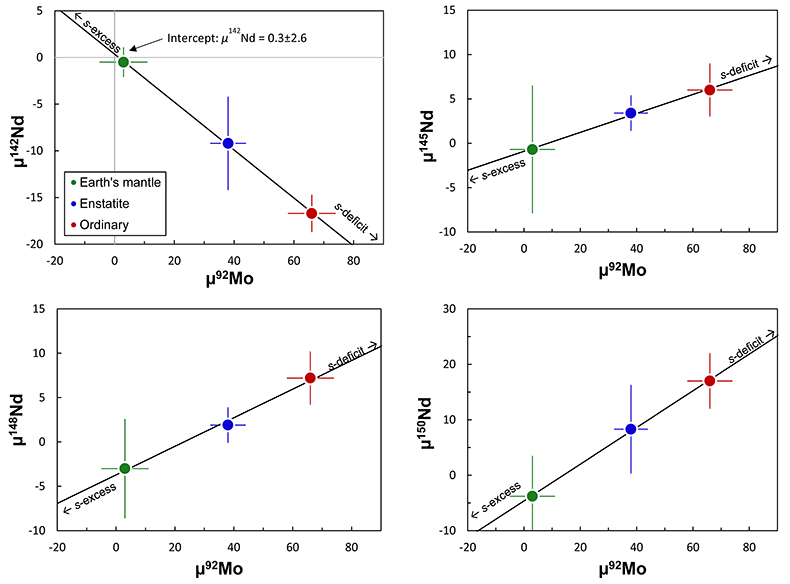
Figure 2 Cosmic Mo-Nd isotope correlation. Mo isotopic data for enstatite and ordinary chondrites from this study, Nd isotopic data are from Burkhardt et al. (2016)
Burkhardt, C., Borg, L.E., Brennecka, G.A., Shollenberger, Q.R., Dauphas, N., Kleine, T. (2016) A nucleosynthetic origin for the Earth’s anomalous 142Nd composition. Nature 537, 394–398.
. For a plot with carbonaceous chondrites included see Figure S-4. Regression of µ142Nd versus µ92Mo calculated using IsoPlot. The good alignment of the data combined with the observation that both 142Nd and non-radiogenic Nd isotopes are correlated with µ92Mo indicates that the 142Nd difference between Earth’s mantle and chondrites is solely nucleosynthetic in origin.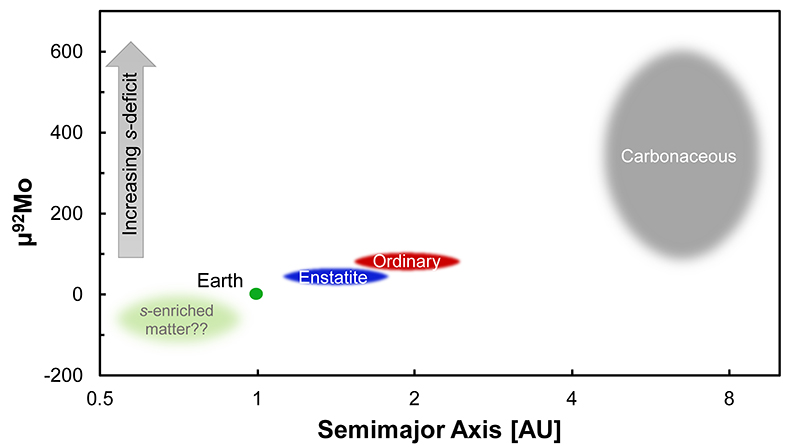
Figure 3 µ92Mo versus heliocentric distance. Range of µ92Mo for carbonaceous chondrites from Burkhardt et al. (2011)
Burkhardt, C., Kleine, T., Oberli, F., Pack, A., Bourdon, B., Wieler, R. (2011) Molybdenum isotope anomalies in meteorites: Constraints on solar nebula evolution and origin of the Earth. Earth and Planetary Science Letters 312, 390–400.
. Heliocentric distances are based on the Grand Tack model, in which bodies between 3 and 6 AU were largely incorporated into Jupiter.Back to article
Supplementary Figures and Tables
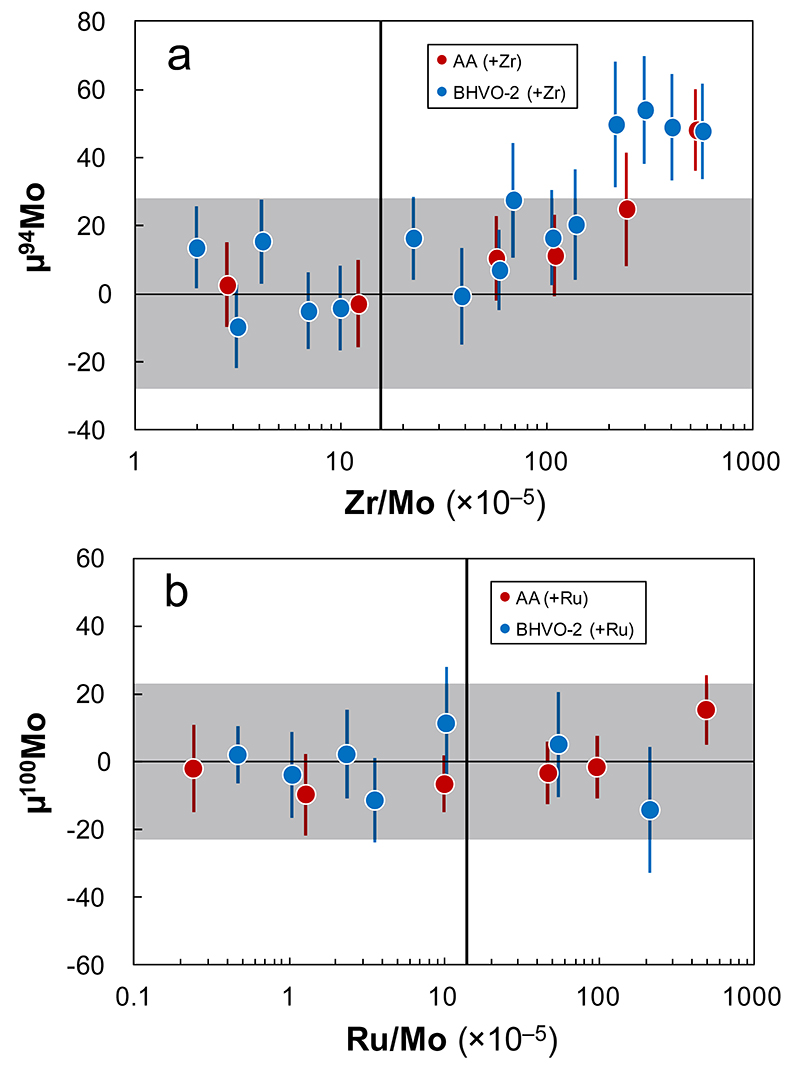
Figure S-1 Doping tests for interference corrections from Zr and Ru. (a) Measured µ94Mo for samples doped with Zr. (b) Measured µ100Mo for samples doped with Ru. The grey area represents the external reproducibility (2 s.d.) defined by repeated analyses of different digestions of the (undoped) BHVO-2 terrestrial basalt standard. Vertical lines represent the maximum values observed for samples in this study.
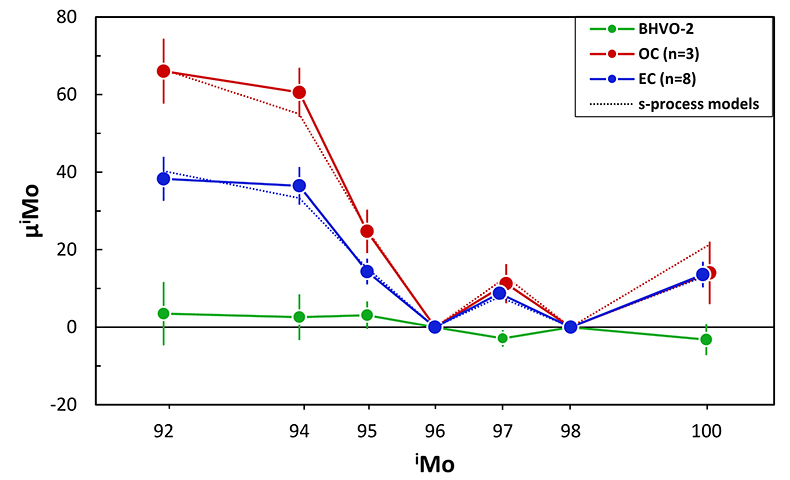
Figure S-2 µiMo vs. iMo showing the average Mo isotopic compositions for enstatite and ordinary chondrites as well as BHVO-2. Dotted lines represent the expected composition for deficits in s-process Mo nuclides relative to terrestrial Mo, calculated using the stellar model of Arlandini et al. (1999).
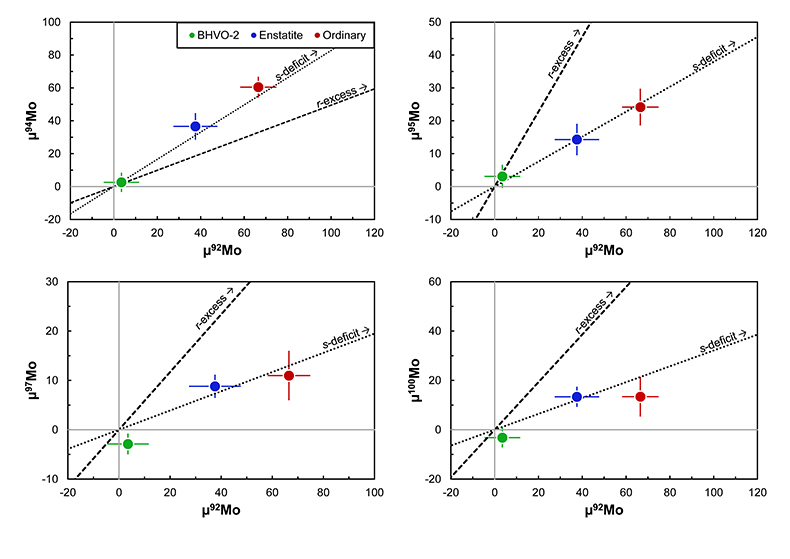
Figure S-3 Plots of µiMo vs. µ92Mo with group means for enstatite and ordinary chondrites as well as BHVO-2. Dotted and dashed lines are mixing lines between terrestrial Mo and s- or r-process Mo, respectively (Arlandini et al., 1999).
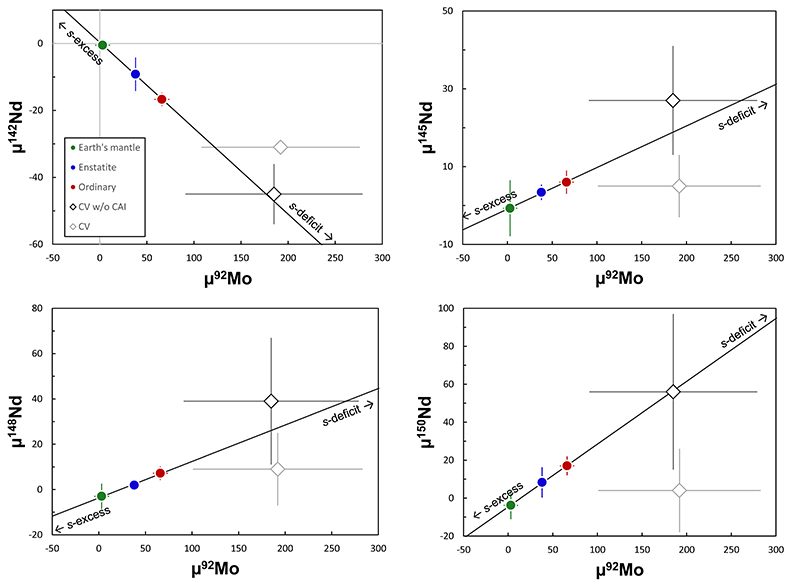
Figure S-4 Plots of µiNd vs. µ92Mo. Bulk CV chondrites do not plot on the Mo-Nd correlation line defined by enstatite chondrites, ordinary chondrites and Earth’s mantle. Using mass balance calculations (Section S-2 and Table S-2), however, the effect of CAIs within CV chondrites can be eliminated and the resulting isotopic composition of CAI-free CV chondrites plot on the aforementioned correlation line.
Table S-1 Compilation of Mo isotopic compositions of CV chondrites.
| Sample | µ92Moa | µ94Moa | µ95Moa | µ97Moa | µ100Moa | Source |
| Allende | 243 ± 151 | 185 ± 103 | 167 ± 74 | 109 ± 61 | 96 ± 91 | Dauphas et al., 2002 |
| Allende | 335 ± 36 | 244 ± 25 | 168 ± 9 | 82 ± 16 | 110 ± 14 | Burkhardt et al., 2011 |
| Allende (MS-A) | 141 ± 27 | 97 ± 19 | 81 ± 5 | 40 ± 8 | 44 ± 12 | Budde et al., 2016 |
| Allende (MS-A) | 140 ± 14 | 101 ± 6 | 84 ± 5 | 44 ± 5 | 49 ± 8 | This study |
| Allende (MS-A) | 147 ± 26 | 97 ± 19 | 86 ± 8 | 45 ± 5 | 54 ± 9 | This study |
| Mean MS-A (±2 s.d.) | 143 ± 8 | 98 ± 5 | 84 ± 5 | 43 ± 5 | 49 ± 10 | |
| Allende (MS-B) | 47 ± 18 | 10 ± 17 | 49 ± 19 | 20 ± 10 | 10 ± 14 | Budde et al., 2016 |
| NWA 6717 | 227 ± 37 | 132 ± 27 | 108 ± 16 | 54 ± 10 | 72 ± 19 | This study |
| Vigarano | 149 ± 37 | 86 ± 27 | 75 ± 16 | 35 ± 10 | 72 ± 19 | |
| Efremovka | 201 ± 37 | 128 ± 27 | 113 ± 16 | 52 ± 10 | 68 ± 19 | |
| Mean (±95 % conf.) | 192 ± 84 | 126 ± 69 | 109 ± 42 | 56 ± 28 | 68 ± 30 | |
a Isotope data are mass-bias corrected by normalising to 98Mo/96Mo = 1.453171 and using the exponential law. Data are reported relative to the terrestrial bracketing standard: µiMo = (µiMo/96Mosample / µiMo/96Mostandard –1) × 106. Uncertainties for samples from this study measured more than three times (MS-A) are given as Student's t-values 95 % confidence intervals. For samples measured n ≤ 3 times (NWA 6717, Vigarano and Efremovka), quoted uncertainties are given as external uncertainties as defined by the standard deviation (2 s.d.) of repeated analyses from replicate digestions of BHVO-2 reference samples.
Back to article | Download in ExcelTable S-2 Isotopic mass balance calculations for Mo (CAI fraction = 0.03).
| Sample | Mo (ppm) | µ92Moa | µ94Moa | µ95Moa | µ97Moa | µ100Moa |
| Bulk CV | 1.42 | 192 ± 84 | 126 ± 69 | 109 ± 42 | 56 ± 28 | 67 ± 30 |
| CAIs | 3.50 | 274 ± 21 | 123 ± 19 | 197 ± 8 | 89 ± 7 | 131 ± 22 |
| CV w/o CAIs | 1.35 | 185 ± 91 | 126 ± 75 | 102 ± 45 | 53 ± 30 | 62 ± 33 |
a Isotope data are mass-bias corrected by normalising to 98Mo/96Mo = 1.453171 and using the exponential law. Data are reported relative to the terrestrial bracketing standard: µiMo = (µiMo/96Mosample / µiMo/96Mostandard –1) × 106. CAI modal abundances from Hezel et al. (2008).
Back to article | Download in Excel





